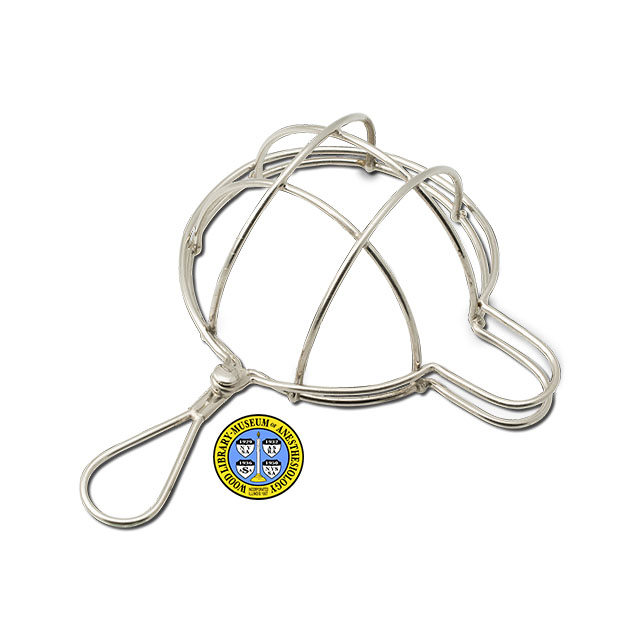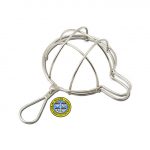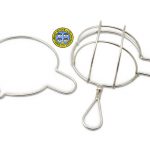Ochsner Mask
Open-drop anesthesia masks were introduced in the 1860s. The mask shown here would have been covered with several layers of gauze. The cloth was then fixed in place by a metal ring, and gradually saturated with either chloroform, or ether. The mask is called the "Ochsner mask" in most publications, but none has been found to-date that explains how it got this name. One candidate for the honor is Chicago surgeon, Edward H. Ochsner, M.D., F.A.C.S. (1868-1956), who introduced an aspirating trocar of his own design in 1903. He also published several articles opposing socialized medicine in the 1930s. Variations of the Ochsner mask were manufactured by numerous companies in the United States and Great Britain from the early 1900s through the 1960s. Some catalogs name it the "Mayo mask" although, here again, nothing has been found to link the two. Even John S. Lundy, M.D. (1894-1973), founder of the Mayo Clinic's Department of Anesthesiology, calls it "Ochsner's mask" in his 1942 textbook, Clinical Anesthesia.
Catalog Record: Ochsner Mask Ochsner Mask
Access Key: aqsz
Accession No.: 65-175
Title: Ochsner mask
Title variation: Alt Title
Title: Mayo mask.
Title variation: Alt Title
Title: SandS mask.
Title variation: Alt Title
Title: Sanders mask.
Publisher: [Place of manufacture not indicated] : [Name of manufacturer not indicated], [between ca. 1900 and ca. 1970].
Physical Description: 1 anesthesia mask : metals ; 6 x 20 x 15.5 cm.
Subject: Anesthesia, Inhalation – instrumentation.
Subject: Masks, Anesthesia – wire frame.
Note Type: General
Notes: The range of possible dates of manufacture is based on the earliest and latest published references to this design found by the cataloger.
Described from the anesthesiologist’s perspective, as when seated at the head of the operating table, with the mask in his right hand.
Note Type: Citation
Notes: Dodds S. A study of seven hundred general anesthesias by the drop method. Illinois Medical Journal. July, 1912;22(1):30-50.
Note Type: Citation
Notes: Feick Brothers. Illustrated Catalogue and Price List of Surgical Instruments. Pittsburgh, Pennsylvania: Feick Brothers, 1905:2005.
Note Type: Citation
Notes: Lentz, Charles, & Sons. Illustrated Catalogue and Price List of Surgical Instruments Hospital Supplies Orthopedic Apparatus, Trusses, etc., 7th ed. Philadelphia: Charles Lentz & Sons, 1911:5.
Note Type: Citation
Notes: Lundy JS. Clinical Anesthesia: A Manual of Clinical Anesthesiology. Philadelphia: Saunders, 1942:288.
Note Type: Citation
Notes: Ochsner EH. An aspirating trocar. Annals of Surgery. May, 1903;37(5):769-771.
Note Type: Citation
Notes: Edward H. Ochsner. Find A Grave website. https://www.findagrave.com/memorial/174192241/edward-h.-ochsner. Accessed April 2, 2018.
Note Type: Citation
Notes: Piper LP. A few remarks on general anaesthesia. Iowa Medical Journal. June 15,1907;13(12):599-602.
Note Type: Citation
Notes: J. Sklar Manufacturing. Surgical Instruments, Suction and Pressure Apparatus, 17th ed. Long Island City, NY: J. Sklar Manufacturing Col, 1967:34-35.
Note Type: Citation
Notes: Wikipedia website. https://en.wikipedia.org/wiki/J._Wellington_Wimpy. Accessed April 2, 2018.
Note Type: Citation
Notes: Charles Willms Surgical. Illustrated and Descriptive Catalogue and Price-List of Surgical Instruments, 3rd ed. Baltimore: Charles Willms Surgical Instrument Co., ca. 1912:39.
Note Type: Physical Description
Notes: One anesthesia mask; Consists of two parts, a wire frame and a hoop or ring that fits over it; The frame is essentially round, with an oval extension on the front (twelve o’clock) meant to cover the patient’s nose; A handle consisting of a wire loop is attached at the back (three o’clock); A metal button stands upright on the handle near the point of its attachment to the frame; A dome is formed by four wire struts, two that are attached at the left and right, and two that are attached at the front and back; The ring has a small extension on the right side that fits snugly beneath the button; When covered with layers of gauze, the ring holds the cloth in place and the button holds the ring in place; There are no manufacturer’s or other marks, with the exception of the WLM accession number painted on the handle, “64-175”.
Note Type: Reproduction
Notes: Photographed by Mr. Steve Donisch, January 16, 2018.
Note Type: Historical
Notes: Open drop anesthesia masks were first introduced in the 1860s. The mask shown here consists of a round wire frame with an extension to cover the patient’s nose. Layers of gauze were stretched over the frame, held in place by a wire ring, and secured by a button-shaped catch. The gauze would be gradually saturated by drops of liquid chloroform or ether. Usually called the Ochsner mask, variations of this design were manufactured by numerous companies in the United States and Great Britain from the early 1900s through the 1960s. It is believed to have been invented by the Chicago surgeon, Edward H. Ochsner, M.D., F.A.C.S. (1868-1956), who introduced an aspirating trocar of his own design in 1903. He also published several articles opposing socialized medicine in the 1930s.
John S. Lundy, M.D., founder of the Department of Anesthesiology at the Mayo Clinic, mentioned the Ochsner mask in his 1942 textbook, Clinical Anesthesia. Perhaps that explains why the mask is sometimes called the “Mayo mask”. By the 1910s, a folding version of the Ochsner mask had been introduced by the Chicago manufacturer, Sharp & Smith. That company’s logo was “SandS”, and the folding Ochsner mask was sometimes called the “Sands” mask. Both the original and the folding Ochsner masks were also sometimes called “Sanders” masks. The shape of the mask strongly resembles head of the cartoon character “J. Wellington Wimpy”, best known as a minor character in the “Popeye the Sailor” cartoons.
The Ochsner Mask is very similar to the Clayton Mask found by the cataloger in three manufacturer’s catalogs, all issued in the 1910s. The principal difference between the two is that the Clayton mask has a twisted wire handle, while the Ochsner mask has a wire loop handle.
Note Type: Exhibition
Notes: Selected for the WLM website.



